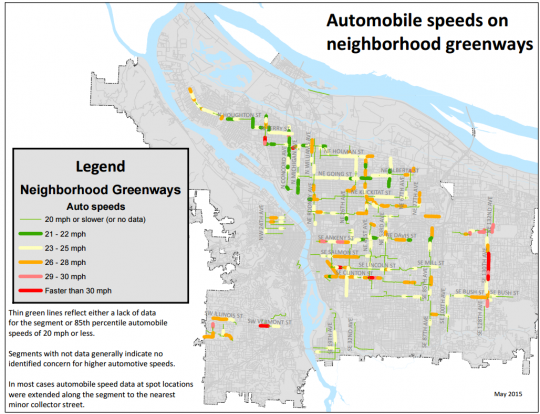
Speeding is routine on more than half of Portland’s celebrated neighborhood greenway system, according to a yet-to-be-released city study.
Almost no neighborhood greenway in Portland’s network is free of stretches where numerous cars are speeding.
Three years after Portland received state permission to lower speed limits on its side-street bikeway network to 20 mph, numerous stretches of neighborhood greenways see substantial amounts of traffic moving at 26 mph and above.
The speeds measured above, compiled as part of a city-ordered study of the neighborhood greenway system, are 85th percentile speeds, which means that 15 percent of cars are moving faster and 85 percent are moving slower. Transportation engineers typically use this as their basic measure of the “natural” speed of traffic on a street.

(Photo: M.Andersen)
Unlike with the traffic volume figures released by the city in March, almost no neighborhood greenway in Portland’s network is free of stretches where numerous cars are speeding. Streets where the 85th percentile speed exceeded 30 mph included SE Clinton Street just east of Cesar Chavez Boulevard; SE Harrison Street just east of 22nd; and N Wabash Avenue just south of Lombard.
Two of the stretches marked in red on the map above actually have bike lanes (SW Vermont Street near Hillsdale) or are expected to (SE 130th between Stark and Division), so they aren’t neighborhood greenways in the usual sense.
At 30 mph, the City of Portland says, someone who hits a person with their car will kill them about 50 percent of the time. At 20 mph, it says the chance of a fatality falls to 10 percent.

Advertisement
The city released its traffic volume findings in March but hasn’t released the speed findings, saying that they are best shared in the context of a written report that isn’t finished. BikePortland received the map above from biking advocate Terry Dublinski-Milton, who got a copy as part of his neighborhood advocacy work.

(Photo: Portland Bureau of Transportation)
The speed findings for neighborhood greenways come as Portland’s city council prepares to approve a pledge to eventually eliminate traffic deaths of people driving, walking and biking. Also today, the city is asking the Oregon Speed Zone Board to give the city more flexibility to lower speed limits on many streets and also testifying in a Salem hearing for House Bill 2621, which would let the city install 20 photo-radar speed cameras on 10 of its most dangerous arterials.
For the last decade or so, the city has relied on ever-closer speed bumps to control speeds on neighborhood greenways. However, advocates like Dublinski-Milton and others say that another measure would also have this effect: traffic diverters.

(Photo: J.Maus/BikePortland)
These barriers are traditionally intended to prevent cut-through auto traffic on the streets, making them feel essentially like urban park space: usable by cars but good for biking, sports and other outdoor activities. But it’s also possible that cut-through traffic tends to be inherently faster-moving than local traffic, so diverters could reduce speeds too.
Two weeks ago, in the wake of a neighborhood meeting to address a series of high-profile traffic collisions, Mayor Charlie Hales’ office announced a new program to install more experimental traffic diverters on neighborhood greenways. But so far neither the Mayor or PBOT Commissioner Steve Novick have announced where or when the experiment will take place.
The announcement came in response to increasingly loud consensus among biking advocates that the greenway system, which has been Portland’s most important investment in new bike infrastructure so far this decade, has been failing in key points.
The city has also tried to call more attention to its posted 20 mph limits by starting to post “neighborhood greenway” signs beneath them.
Correction 6/18: An earlier version of this post suggested that all neighborhood greenways have 20 mph speed limits. They typically do, with some possible exceptions.


